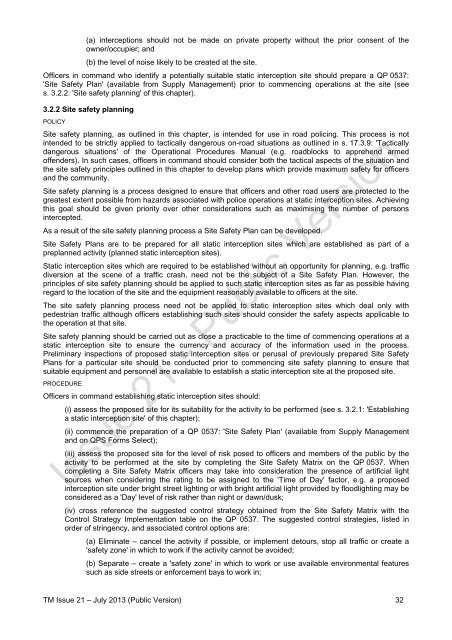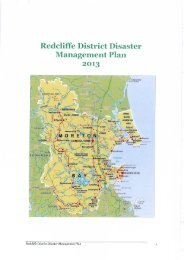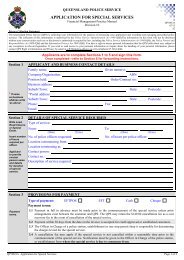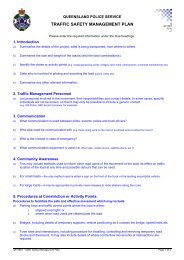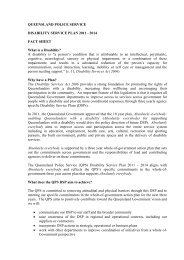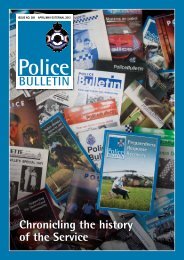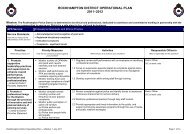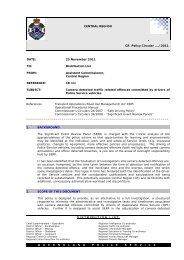Traffic Manual - Queensland Police Service
Traffic Manual - Queensland Police Service
Traffic Manual - Queensland Police Service
Create successful ePaper yourself
Turn your PDF publications into a flip-book with our unique Google optimized e-Paper software.
(a) interceptions should not be made on private property without the prior consent of the<br />
owner/occupier; and<br />
(b) the level of noise likely to be created at the site.<br />
Officers in command who identify a potentially suitable static interception site should prepare a QP 0537:<br />
'Site Safety Plan' (available from Supply Management) prior to commencing operations at the site (see<br />
s. 3.2.2: 'Site safety planning' of this chapter).<br />
3.2.2 Site safety planning<br />
POLICY<br />
Site safety planning, as outlined in this chapter, is intended for use in road policing. This process is not<br />
intended to be strictly applied to tactically dangerous on-road situations as outlined in s. 17.3.9: 'Tactically<br />
dangerous situations' of the Operational Procedures <strong>Manual</strong> (e.g. roadblocks to apprehend armed<br />
offenders). In such cases, officers in command should consider both the tactical aspects of the situation and<br />
the site safety principles outlined in this chapter to develop plans which provide maximum safety for officers<br />
and the community.<br />
Site safety planning is a process designed to ensure that officers and other road users are protected to the<br />
greatest extent possible from hazards associated with police operations at static interception sites. Achieving<br />
this goal should be given priority over other considerations such as maximising the number of persons<br />
intercepted.<br />
As a result of the site safety planning process a Site Safety Plan can be developed.<br />
Site Safety Plans are to be prepared for all static interception sites which are established as part of a<br />
preplanned activity (planned static interception sites).<br />
Static interception sites which are required to be established without an opportunity for planning, e.g. traffic<br />
diversion at the scene of a traffic crash, need not be the subject of a Site Safety Plan. However, the<br />
principles of site safety planning should be applied to such static interception sites as far as possible having<br />
regard to the location of the site and the equipment reasonably available to officers at the site.<br />
The site safety planning process need not be applied to static interception sites which deal only with<br />
pedestrian traffic although officers establishing such sites should consider the safety aspects applicable to<br />
the operation at that site.<br />
Site safety planning should be carried out as close a practicable to the time of commencing operations at a<br />
static interception site to ensure the currency and accuracy of the information used in the process.<br />
Preliminary inspections of proposed static interception sites or perusal of previously prepared Site Safety<br />
Plans for a particular site should be conducted prior to commencing site safety planning to ensure that<br />
suitable equipment and personnel are available to establish a static interception site at the proposed site.<br />
PROCEDURE<br />
Officers in command establishing static interception sites should:<br />
(i) assess the proposed site for its suitability for the activity to be performed (see s. 3.2.1: 'Establishing<br />
a static interception site' of this chapter);<br />
(ii) commence the preparation of a QP 0537: 'Site Safety Plan' (available from Supply Management<br />
and on QPS Forms Select);<br />
(iii) assess the proposed site for the level of risk posed to officers and members of the public by the<br />
activity to be performed at the site by completing the Site Safety Matrix on the QP 0537. When<br />
completing a Site Safety Matrix officers may take into consideration the presence of artificial light<br />
sources when considering the rating to be assigned to the 'Time of Day' factor, e.g. a proposed<br />
interception site under bright street lighting or with bright artificial light provided by floodlighting may be<br />
considered as a 'Day' level of risk rather than night or dawn/dusk;<br />
(iv) cross reference the suggested control strategy obtained from the Site Safety Matrix with the<br />
Control Strategy Implementation table on the QP 0537. The suggested control strategies, listed in<br />
order of stringency, and associated control options are:<br />
(a) Eliminate – cancel the activity if possible, or implement detours, stop all traffic or create a<br />
'safety zone' in which to work if the activity cannot be avoided;<br />
(b) Separate – create a 'safety zone' in which to work or use available environmental features<br />
such as side streets or enforcement bays to work in;<br />
TM Issue 21 – July 2013 (Public Version) 32


